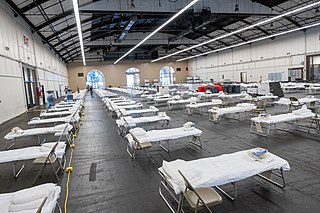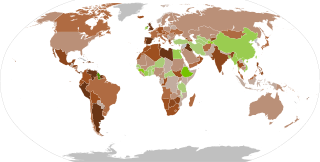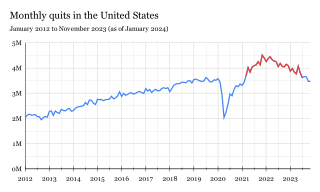
Remote work is the practice of working from one's home or another space rather than from an office.
Home recording is the practice of recording sound in a private home instead of a professional recording studio. A studio set up for home recording is called a home studio or project studio. Home recording is widely practiced by voice actors, narrators, singers, musicians, podcast hosts, and documentary makers at all levels of success. The cost of professional audio equipment has dropped steadily as technology advances during the 21st century, while information about recording techniques has become easily available online. These trends have resulted in an increase in the popularity of home recording and a shift in the recording industry toward recording in the home studio. The COVID-19 pandemic and COVID-19 lockdowns resulted in a dramatic global increase in the number of remote workers in 2020, which is anticipated by experts to remain a permanent shift in the field of sound recording when the pandemic ends.
A virtual workplace is a work environment where employees can perform their duties remotely, using technology such as laptops, smartphones, and video conferencing tools. A virtual workplace is not located in any one physical space. It is usually a network of several workplaces technologically connected without regard to geographic boundaries. Employees are thus able to interact in a collaborative working environment regardless of where they are located. A virtual workplace integrates hardware, people, and online processes.

Coworking is an arrangement in which workers for different companies share an office space. It allows cost savings and convenience through the use of common infrastructures, such as equipment, utilities and receptionist and custodial services, and in some cases refreshments and parcel acceptance services. It is attractive to independent contractors, independent scientists, remote workers, digital nomads, and people who travel frequently. Additionally, coworking helps workers avoid the feeling of social isolation they may experience while remote working or traveling and eliminate distractions in home office. Most coworking spaces charge membership dues. Major companies that provide coworking space and serviced offices include WeWork, IWG plc, Industrious, and Impact Hub.

A key worker is a worker in an occupation given preferential treatment by government policy. They may be exempted from rules which apply to the general population or prioritized for the receipt of benefits.

Digital nomads are people who travel freely while working remotely using technology and the internet. Such people generally have minimal material possessions and work remotely in temporary housing, hotels, cafes, public libraries, co-working spaces, or recreational vehicles, using Wi-Fi, smartphones or mobile hotspots to access the Internet. The majority of digital nomads describe themselves as programmers, content creators, designers, or developers. Some digital nomads are perpetual travelers, while others only maintain the lifestyle for a short period of time. While some nomads travel through multiple countries, others remain in one area, and some may choose to travel while living in a vehicle, in a practice often known as van-dwelling. In 2023, there are 17.3 million American digital nomads, which is a 131% increase since 2019.

Van-dwelling or vanlife is an unconventional lifestyle of living in a car, van or other motor vehicle. A person who lives in such a manner, either on a full or part-time basis, is known as a van dweller, car dweller or vehicle dweller. People who live this way by choice are typically seeking a more self-sufficient lifestyle characterized by freedom and mobility. They may perceive it as being a less regulated form of housing, or one that offers a lower cost advantage over standard housing, especially in regions susceptible to housing shortages. Other van dwellers may be one step away from living on the street or in a shelter.

Zoom Video Communications, Inc. is a communications technology company headquartered in San Jose, California, United States.

Remote Year is a company that facilitates travel and accommodations for people working or interested in working remotely. For $2,000-3,000 per month, Remote Year organizes accommodation, workspaces and professional and local activities to enable participants to travel while continuing to work and to foster a sense of community amongst the group traveling together. The program includes a 12-month trip across 12 cities in various countries. across four continents Remote Year has hosted employees from over 300 companies participating in the program.

Gig workers are independent contractors, online platform workers, contract firm workers, on-call workers, and temporary workers. Gig workers enter into formal agreements with on-demand companies to provide services to the company's clients.

The COVID-19 pandemic affected educational systems across the world. The number of cases of COVID-19 started to rise in March 2020 and many educational institutions and universities underwent closure. Most countries decided to temporarily close educational institutions in order to reduce the spread of COVID-19. UNESCO estimates that at the height of the closures in April 2020, national educational shutdowns affected nearly 1.6 billion students in 200 countries: 94% of the student population and one-fifth of the global population. Closures are estimated to have lasted for an average of 41 weeks. They have had significant negative effects on student learning, which are predicted to have substantial long-term implications for both education and earnings. During the pandemic, education budgets and official aid program budgets for education have decreased.

The COVID-19 pandemic has impacted the mental health of people across the globe. The pandemic has caused widespread anxiety, depression, and post-traumatic stress disorder symptoms. According to the UN health agency WHO, in the first year of the COVID-19 pandemic, prevalence of common mental health conditions, such as depression and anxiety, went up by more than 25 percent. The pandemic has damaged social relationships, trust in institutions and in other people, has caused changes in work and income, and has imposed a substantial burden of anxiety and worry on the population. Women and young people face the greatest risk of depression and anxiety. According to The Centers for Disease Control and Prevention study of Mental Health, Substance Use, and Suicidal Ideation During the COVID-19 Pandemic, "63 percent of young people reported experiencing substantial symptoms of anxiety and depression".

Zoombombing or Zoom raiding is the unwanted, disruptive intrusion, generally by Internet trolls, into a video-conference call. In a typical Zoombombing incident, a teleconferencing session is hijacked by the insertion of material that is lewd, obscene, or racist in nature, typically resulting in the shutdown of the session or the removal of the troll. The term is especially associated with and is derived from the name of the Zoom videoconferencing software program, but it has also been used to refer to the phenomenon on other video conferencing platforms. The term became popularized in 2020 when the COVID-19 pandemic forced many people to stay at home, and videoconferencing came to be used on a large scale by businesses, schools, and social groups.

Strikes occurred during the COVID-19 pandemic due to many factors including: hazard pay or low pay, unsafe working conditions, inability to pay rent. These strikes are separate from the various protests that occurred over responses to the pandemic.

The San Francisco Bay Area, which includes the major cities of San Jose, San Francisco, and Oakland, was an early center of the COVID-19 pandemic in California. The first case of COVID-19 in the area was confirmed in Santa Clara County on January 31, 2020. A Santa Clara County resident was the earliest known death caused by COVID-19 in the United States, on February 6, suggesting that community spread of COVID-19 had been occurring long before any actual documented case. This article covers the 13 members of ABAHO, which includes the nine-county Bay Area plus the counties of Monterey, San Benito, and Santa Cruz.

The economic impact of the COVID-19 pandemic in the United States has been widely disruptive, adversely affecting travel, financial markets, employment, shipping, and other industries. The impacts can be attributed not just to government intervention to contain the virus, but also to consumer and business behavior to reduce exposure to and spread of the virus.

Individuals with disabilities are more susceptible to contracting COVID-19 and have higher mortality rates compared to those without disabilities. This is particularly true for people with intellectual and developmental disabilities, those residing in care facilities, and women with disabilities. Individuals with disabilities face heightened risks of mental health issues related to the pandemic, such as increased feelings of loneliness and isolation. They were also more likely to face domestic violence and abuse during the pandemic. People with disabilities are more likely to experience unemployment as a result of the pandemic and may require changes to the types of accommodations they require for work. Children with disabilities experience complications in their educational programming. Remote learning poses a host of challenges for children with disabilities, including disruptions to physical and occupational therapies and access to assistive technologies.

The COVID-19 pandemic swept the world in the early months of 2020, causing massive economic and social disruption. In addition to the disease itself, populations have often dealt with lockdowns, shortages and pandemic fatigue, political and cultural turmoil. This has made the pandemic era a time of exceptional stress. The pandemic has driven some people to seek peaceful escapism in media, but others towards fictional pandemics as an alternate form of escapism.
Zoom fatigue is tiredness, worry, or burnout associated with the overuse of online platforms of communication, particularly videotelephony. The name derives from the cloud-based videoconferencing and online chat software Zoom, but the term can be used to refer to fatigue from other video conferencing platforms.

The Great Resignation, also known as the Big Quit and the Great Reshuffle, was a mainly American economic trend in which employees voluntarily resigned from their jobs en masse, beginning in early 2021 during the COVID-19 pandemic. Among the most cited reasons for resigning included wage stagnation amid rising cost of living, limited opportunities for career advancement, hostile work environments, lack of benefits, inflexible remote-work policies, and long-lasting job dissatisfaction. Most likely to quit were workers in hospitality, healthcare, and education. In addition, many of the resigning workers were retiring seniors. Collectively, the Baby Boomers are one of the largest demographic cohorts in the United States.
















